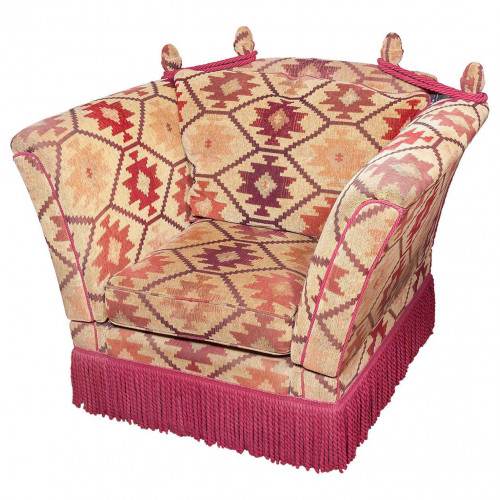A mid-17th century, Spanish, walnut, open armchair retaining its original leather studded upholstery from Fawley Court, Oxon
10349
The rectangular back, with original leather and brass flowerhead studs, above open arms with an old repair to a small section at the back of one arm. The rectangular stuff-over close-nailed seat similarly upholstered. Standing on rectangular legs joined by shaped foliate and leaf carved front stretchers, shaped side stretchers and straight back stretcher. Original colour and patina. Second half of the 17th century.
17th Century
1650
Walnut & leather
Spain
Provenance : Marian Fathers, Fawley Court, Henley-on-Thames, Oxfordshire Fawley Court stands on a site that has been occupied for over a thousand years, and is a unique surviving example of a Wren country house set on the banks of the Thames nestling in beautiful parkland that has remained unchanged for 150 years. The name "Fawley" comes from the Old English word for fallow deer, great herds of which once roamed this countryside. Fawley Court is mentioned for the first time in the Doomsday Book as being owned by Walter Gifford, brother-in-law of William I. In 1470, Fawley Court passed in marriage on Thomas Rokes. In 1616, Fawley Court was sold to Sir James Whitelock. In the 1670's, Fawley Court was sold to Colonel William Freeman who employed by Sir Christopher Wren to re-model the house as a magnificent, family home. The best craftsmen were employed throughout and the breathtaking carved ceiling in the Drawing Room, a work by Grinling Gibbons from 1690, is one of only three in the country to survive to the present day. In 1684, the work on the house was completed and the park was decorated with ancient statues. In the 1770's, James Wyatt redecorated the interiors and Lancelot "Capability" Brown re-designed the park. In 1853, Fawley Court was sold to Edward Mackenzie. During World War 2, Fawley Court was a training place for special troops. In 1952, the Mackenzie family sold most of the contents of the house. Since 1952 Fawley Court has belonged to Polish Congregation of Marian Fathers. It is most likely that these Spanish chairs have been in the house since the 17th or early-18th century.
















